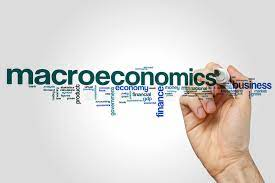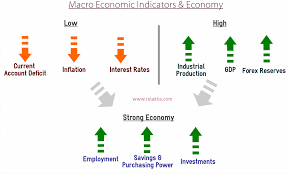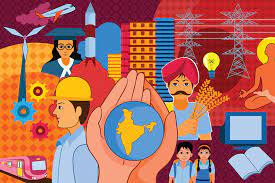Macroeconomics, the study of a nation’s economic performance on a grand scale, provides a comprehensive view of India’s economic landscape. As one of the world’s most populous and rapidly developing nations, India’s macroeconomics plays a crucial role in global economics. In this blog, we will delve into the key aspects of India’s macroeconomic situation, highlighting its growth, inflation, fiscal policy, exchange rates, challenges, and opportunities.

India has been on a remarkable growth trajectory for the past few decades. Its vast and diverse economy has seen significant expansion. The services sector, especially information technology and business process outsourcing, has been a driving force behind this growth. Additionally, the manufacturing sector, infrastructure development, and the emergence of startups have all contributed to India’s impressive economic performance.
When it comes to inflation and monetary policy Inflation, the rise in prices is a critical part of India’s macroeconomics. The Reserve Bank of India, which acts like India’s money manager, uses tools like changing interest rates and buying/selling government bonds to control inflation and make sure prices don’t go too high. This helps keep the economy stable and growing.

The Indian government’s fiscal policy is instrumental in shaping the nation’s economic outlook. Government spending on infrastructure projects, education, healthcare, and social welfare programs has a direct impact on the economy. As India continues to invest in infrastructure development, it seeks to create a favourable environment for businesses and promote inclusive growth.
Exchange rates and international trade are closely connected to India’s macroeconomics. The value of the Indian rupee affects how well India can sell its goods to other countries. A lower rupee can help boost exports, while a stronger rupee can attract foreign investments. Keeping a balance in trade and having enough foreign money in reserves are key to India’s economic stability.

India faces various challenges in its macroeconomic journey. Income inequality remains a concern, with a substantial portion of the population still living in poverty. Unemployment and underemployment are issues that need to be addressed for sustainable growth. However, these challenges also present opportunities for the government and businesses to innovate and implement inclusive policies that can lift millions out of poverty and create new avenues for growth.
India’s macroeconomics is a complex and dynamic web of factors that influence its economic growth and stability. As the nation continues to evolve and modernize, understanding its macroeconomic landscape becomes increasingly important for businesses, policymakers, and economists. The growth story of India is far from over, and as it surges ahead, its impact on the global economic stage will only become more significant.
WRITTEN BY-MANASHVI JADAV(SYBAF/A)

Leave a comment